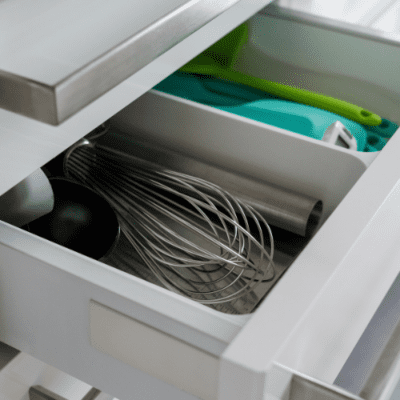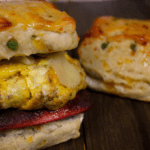One of the biggest complaints I hear about cooking is that it takes too long. For people like me who don’t mind staying in the kitchen all day, this is a thrill, but I realize I am in the minority here. So I’ve put together a list of 10 way to save time in the kitchen.
The list begins with four overarching kitchen hacks that every home cook should seek to incorporate in their cooking/baking routines. You can apply them to any and all dishes you hope you make, and mastering them will save you countless amounts of time and effort.
- Read the full recipe first
- Mise-en-place
- Complete parts of the recipe in advance, if possible
- Clean as you go
The final six tips & tricks are more specific and deal with how to cut down on the time, money, and effort spent while cooking and baking using certain ingredients.
- Soften stale brown sugar
- Soften butter quickly
- Quick room-temperature eggs
- How to easily remove egg shell
- Crack eggs in a seprate bowl
- Making homemade buttermilk
Incorporating these into your kitchen routine will help you avoid headaches and wasted money the next time you go to prepare a meal for you and your loved ones. So let’s get started.
Master the basics
(1) First thing’s first, read the recipe all the way through
If you are following a recipe, read it through at least once. I can’t tell you how many times I’d been preparing a dish and had to make the choice to either (1) run back out to the store for an ingredient I had neglected or (2) call it quits because I’m missing a vital part of the recipe.
Learn from my mistakes. Please. Read the recipe in full. Twice is always nice.
First, read the ingredients list. Then check out what kind of equipment you will need to successfully make the dish. Once all of this checks out, yes, you still need to read the step-by-step instructions.
Why? Not every author structures their recipes the same. Inside the step-by-step instructions is where the specifics of what the recipe requires become really clear. Will you need softened butter at the beginning of the process or later? Is all of the salt going into one bowl or is it separated and spread across multiple steps in the recipe? This is also where you learn about any techniques that are required to make the dish. If anything is too foreign to you, you can take the time to look it up before you actually start cooking. So take your time and familiarize yourself with the full recipe before jumping in head first.
(2) Mise-en-place
Mise-en-place is just a French term for preparing and organizing all the ingredients you will need to prepare a meal before you start cooking. For the professional line cook, this practice is NECESSARY, but for the home cook, it is just a great way to save time in the kitchen and save energy while you cook.

I know it may seem odd to suggest that spending a bunch of time upfront chopping and measuring incredients saves time, but hear me out. Mise-en-place-ing at the beginning allows you to focus on cooking in the moment. Instead of having to pause between each step of the recipe to mince garlic or measure flour, your mise-en-place preparation keeps things flowing.
It may be comforting to know that not every meal you cook at home needs mise-en-place. First, if you read the recipe and see words like “immediately after” or “at the same time”, it is likely that a mise-en-place will be helpful. The language is telling you that more than one ingredient will be needed at the same time. You can save time in the kitchen by having both of these ingredients in the proper form (chopped, sliced, seasoned, etc.) to use.
Another type of recipe that usually benefits from mise-en-place are baking recipes. All of the measurements for flour, sugar, baking powders, etc. can get mixed up easily. Also, getting the precise measuring out of the way at the beginning helps to streamline the baking process.
Any other recipes that intimidate you or have a bunch of steps could also benefit from preparing and measuring out your ingredients ahead of cooking time. There’s no need to add the pressure to food prep and measuring on top of executing complicated cooking techniques.
So grab a knife and a cutting board. Gather plenty of ramekins, bowls, tupperware containers, measuring cups, or anything else you have available to contain ingredients. Go through your recipe (yes, AGAIN) and get half of the hard work out of the way right out of the gate.
(3) Complete parts of the recipe in advance, if possible
There’s no need to wait until right before a large dinner party to complete all of the dozens of steps it will take to finish that meal. That is draining and downright unncessary. Start by preparing your mise-en-place just as soon as you have the ingredients you need to prep.
Marinating your proteins ahead of time actually makes for a more flavorful dish, so do this as soon as possible. Getting that out of the way will also cut down on potential cross-contamination while dealing with ingredients that won’t be cooked to as high of a temperature.
Dishes like baked macaroni and cheese can be cooked and assembled the night before then finished in the oven right before the big event. Desserts like cupcakes and cakes can be baked ahead, stored in airtight containers, then decorated the day-of.
(4) Clean as you go

Most of our homecooked meals begin in a clean kitchen. I’ll take it even further and say that some of us are even inspired by a clean kitchen. Inspired to cook… What, exactly? Sometimes I have no idea until I open my refrigerator, but either way, something is going to be cooked/baked. This will inevitably produce dirty dishes. And nothing puts a damper on a delicious meal like knowing you have a mountain of dishes to attend to sometime after eating it.
Avoid the mountain by taking short breaks to attend to a dirty dish or three here and there while you’re cooking or baking. For example, if you’re baking a batch of cupcakes, you will need plenty of measuring spoons and bowls. After pouring the ingredients into a stand mixer, instead of letting those dishes sit, wash them. You will have a minute while the batter is being whipped up to either stand there and watch it spin or get a headstart on cleaning up.
While food is in the oven is always a great time to start cleaning up the counterspaces and dishes that are no longer needed. Keeping a wet rag on hand will make it easy to clean spills quickly and avoid sticky or stained surfaces.
If you are cooking a dish that doesn’t have any breaks between the steps, prepare a sink half-full of soapy water to soak dishes as they’re used. By the end of the meal you will have way less mess to clean up and your dishes will be way easier to wash.
Useful Cooking & Baking “Hacks”
(5) Softening hard brown sugar
Brown sugar. It’s highly versatile and used in both sweet and savory recipes. It’s always a good idea to have at least a small bag around, in my opinion. The best way to store it is in an air-tight container or sealed inside a bag. When you leave brown sugar out and exposed to the open air, it dries out and becomes quite hard. If you can manage to get the amount you need separated from the block of sugar, it will take longer to incorporate into your dish. It’s just overall, not ideal to have crusty brown sugar.
So what to do when you discover that your brown sugar is in a less than manageable state?
Grab a few apple slices, a slice of bread or even a handful of marshmallows—all three of these help put moisture back into the sugar. Lay them on top of the hardened mass in a sealed plastic bag or another airtight container and the brown sugar will be back to normal in about a day or two.
(6) Softening butter
So you’ve got a recipe for cookies or cupcakes or something else where you have to whip the butter. The instructions are probably going to list the butter as “softened”, which will allow for smooth and easy whipping. Great, that’s pretty simple. If you actually remember to do this ahead of time, just take the stick(s) of butter out of the fridge before you need to use it. Depending on the temperature in your home, the butter will be perfect for whipping in between one and two hours.

But what if you forget? Or what if you just all of a sudden want something sweet (because I know from personal experience that sweet tooth cravings can hit you like a ton of bricks)? You’re standing in your kitchen ready to make a batch of cookies, but the butter you need to use is still rock hard. Now what?
Take your stick(s) of butter and put them in of a ziplock bag. Make sure there isn’t a bunch of extra air in the bag then seal them inside. Then fill a bowl or cup with warm water, and place butter in the bowl/cup for 2-3 minutes.
You can squeeze the stick gently to check how soft it is. You want the butter to give but not be melting. Melting butter will be a slightly darker yellow color. If you melt the butter, this is fine also! Just put the stick back in the fridge for a few minutes until the melting stops. Then you’re ready to use the butter in your recipe.
(7) Quick room-temperature eggs
The same thing (pretty much) applies to those refrigerated eggs that should actually be room-temperature to incorporate into the recipe well. Just pop your eggs into a bowl of warm water for 5 to 10 minutes.
(8) Speaking of eggs, how to remove egg shell
Fingers, spoons, paper towels all seem to do a miserable job at removing the shell efficiently. And there’s a reason for this. The membrane around the egg shell makes it nearly impossible to retrieve. But guess what also has the same membrane? The other piece of the shell!
Use one of the remaining pieces of the egg shell as a scoop to retrieve the lost speck in your culinary creation. Make sure the piece you are using as a scoop doesn’t have any other loose pieces of shell that could fall in while you’re on this delicate mission. The shell scoop and the lost speck won’t repel each other because they have the same membranes and are very familiar with each other already.

(9) Crack eggs into a separate bowl first
To take this whole egg shell thing one step further, you can save lots of headaches and time by cracking eggs into a separate bowl before adding them to any recipe you are using. If you do end up with shell in the mix, it will be alot easier to remove using the methods above when there’s just eggs in the bowl. Even further, if it becomes impossible to remove the egg shell, it’s much better to only have to throw away a few eggs rather than your entire bowl of batter.
(10) Make your own buttermilk
This tip is more of a save-time-by-not-having-to-go-the-store tip. Buttermilk is very versatile and can come in handy in a variety of recipes from pancakes to grilled chicken. Pair it with hot sauce in marinades to your grilled chicken tender and flavorful. Buttermilk also keeps baked goods moist and fluffy. Having some on-hand is just a matter of going to the dairy section of any grocery store, but what happens when you need some in a pinch?
You can make your own! If you have regular whole or 2% milk and a lemon or distilled white vinegar, these two very common kitchen staples can be combined to create your own buttermilk for use in any recipe, just like the store-bought stuff.
Here’s what you need:
1 cup of milk + 1 tbsp of freshly-squeezed lemon juice or distilled white vinegar
After mixing these two, just let it sit for about 5-10 minutes. The mixture will be thick when you return. It won’t be as thick as buttermilk from the store, but I promise it will still do the trick. Make pancakes, biscuits, cupcakes using your own buttermilk, and let me know how it goes!
READ MORE: “5 Ways to Use Leftover Buttermilk”

There are so many little ways that I save time in the kitchen and avoid stress while I’m cooking. I also use less conventional ways to make cooking more fun such as listening to my favorite music or inviting a friend over to watch and help.
This list covers some of the basics and other tricks I use often, but I will make sure to update this series with new posts and new tips, as I think of them. So join the #CocinaCrew by signing up for the weekly mailing list, if you haven’t already, to stay in touch.
In the meantime, here are a couple more ways to save time in the kitchen:
WATCH: Five (5) helpful hacks to use while you’re baking: Tasty: 5 Genius Baking Hacks
READ: Instructions in many recipes that you can actually ignore and save time cooking: Taste of Home: 13 Common Recipe Instructions You Didn’t Know You Could Ignore





Leave a Reply